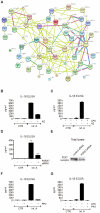Quantitative subcellular proteome and secretome profiling of influenza A virus-infected human primary macrophages
- PMID: 21589892
- PMCID: PMC3093355
- DOI: 10.1371/journal.ppat.1001340
Quantitative subcellular proteome and secretome profiling of influenza A virus-infected human primary macrophages
Abstract
Influenza A viruses are important pathogens that cause acute respiratory diseases and annual epidemics in humans. Macrophages recognize influenza A virus infection with their pattern recognition receptors, and are involved in the activation of proper innate immune response. Here, we have used high-throughput subcellular proteomics combined with bioinformatics to provide a global view of host cellular events that are activated in response to influenza A virus infection in human primary macrophages. We show that viral infection regulates the expression and/or subcellular localization of more than one thousand host proteins at early phases of infection. Our data reveals that there are dramatic changes in mitochondrial and nuclear proteomes in response to infection. We show that a rapid cytoplasmic leakage of lysosomal proteins, including cathepsins, followed by their secretion, contributes to inflammasome activation and apoptosis seen in the infected macrophages. Also, our results demonstrate that P2X₇ receptor and src tyrosine kinase activity are essential for inflammasome activation during influenza A virus infection. Finally, we show that influenza A virus infection is associated with robust secretion of different danger-associated molecular patterns (DAMPs) suggesting an important role for DAMPs in host response to influenza A virus infection. In conclusion, our high-throughput quantitative proteomics study provides important new insight into host-response against influenza A virus infection in human primary macrophages.
Conflict of interest statement
The authors have declared that no competing interests exist.
Figures






Similar articles
-
Recognition of cytoplasmic RNA results in cathepsin-dependent inflammasome activation and apoptosis in human macrophages.J Immunol. 2011 Mar 1;186(5):3085-92. doi: 10.4049/jimmunol.1002051. Epub 2011 Jan 21. J Immunol. 2011. PMID: 21257972
-
Actin and RIG-I/MAVS signaling components translocate to mitochondria upon influenza A virus infection of human primary macrophages.J Immunol. 2009 May 1;182(9):5682-92. doi: 10.4049/jimmunol.0803093. J Immunol. 2009. PMID: 19380815
-
Phosphoproteomics to Characterize Host Response During Influenza A Virus Infection of Human Macrophages.Mol Cell Proteomics. 2016 Oct;15(10):3203-3219. doi: 10.1074/mcp.M116.057984. Epub 2016 Aug 2. Mol Cell Proteomics. 2016. PMID: 27486199 Free PMC article.
-
Proteomics to study macrophage response to viral infection.J Proteomics. 2018 May 30;180:99-107. doi: 10.1016/j.jprot.2017.06.018. Epub 2017 Jun 21. J Proteomics. 2018. PMID: 28647517 Review.
-
Virus systems biology: Proteomics profiling of dynamic protein networks during infection.Adv Virus Res. 2021;109:1-29. doi: 10.1016/bs.aivir.2020.12.001. Epub 2021 Jan 4. Adv Virus Res. 2021. PMID: 33934824 Review.
Cited by
-
The Impact of Mass Spectrometry-Based Proteomics on Fundamental Discoveries in Virology.Annu Rev Virol. 2014 Nov;1(1):581-604. doi: 10.1146/annurev-virology-031413-085527. Epub 2014 Jul 14. Annu Rev Virol. 2014. PMID: 26958735 Free PMC article.
-
Impact of Type I and III Interferons on Respiratory Superinfections Due to Multidrug-Resistant Pathogens.J Infect Dis. 2017 Feb 15;215(suppl_1):S58-S63. doi: 10.1093/infdis/jiw466. J Infect Dis. 2017. PMID: 28375519 Free PMC article.
-
Systems approaches to influenza-virus host interactions and the pathogenesis of highly virulent and pandemic viruses.Semin Immunol. 2013 Oct 31;25(3):228-39. doi: 10.1016/j.smim.2012.11.001. Epub 2012 Dec 5. Semin Immunol. 2013. PMID: 23218769 Free PMC article. Review.
-
Tandem Mass Tag-Based Quantitative Proteomic Analysis of Chicken Bursa of Fabricius Infected With Reticuloendotheliosis Virus.Front Vet Sci. 2021 May 25;8:666512. doi: 10.3389/fvets.2021.666512. eCollection 2021. Front Vet Sci. 2021. PMID: 34113672 Free PMC article.
-
Proteomic analysis reveals down-regulation of surfactant protein B in murine type II pneumocytes infected with influenza A virus.Virology. 2015 Sep;483:96-107. doi: 10.1016/j.virol.2015.03.045. Epub 2015 May 15. Virology. 2015. PMID: 25965799 Free PMC article.
References
-
- Akira S, Uematsu S, Takeuchi O. Pathogen recognition and innate immunity. Cell. 2006;124:783–801. - PubMed
-
- Kawai T, Akira S. Innate immune recognition of viral infection. Nat Immunol. 2006;7:131–137. - PubMed
-
- Koyama S, Ishii KJ, Kumar H, Tanimoto T, Coban C, et al. Differential role of TLR- and RLR-signaling in the immune responses to influenza A virus infection and vaccination. J Immunol. 2007;179:4711–4720. - PubMed
-
- Pirhonen J, Sareneva T, Kurimoto M, Julkunen I, Matikainen S. Virus infection activates IL-1β and IL-18 production in human macrophages by a caspase-1-dependent pathway. J Immunol. 1999;162:7322–7329. - PubMed
-
- Pirhonen J, Sareneva T, Julkunen I, Matikainen S. Virus infection induces proteolytic processing of IL-18 in human macrophages via caspase-1 and caspase-3 activation. Eur J Immunol. 2001;31:726–733. - PubMed
Publication types
MeSH terms
Substances
LinkOut - more resources
Full Text Sources
Other Literature Sources
Miscellaneous

